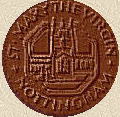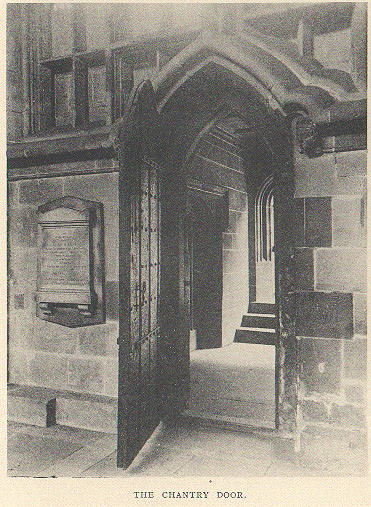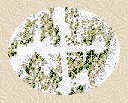 The History of the Parish Church of
St. Mary the Virgin, Nottingham
The History of the Parish Church of
St. Mary the Virgin, NottinghamThe great new Perpendicular Church
 The History of the Parish Church of
St. Mary the Virgin, Nottingham
The History of the Parish Church of
St. Mary the Virgin, Nottingham
The great new Perpendicular Church
There appear to be no surviving documents which give details of the building of the magnificent structure which remains essentially unchanged to this day. So where should we start?
 Perhaps
the most likely clue to the date of commencement of building is the
interior doorway from the church to the South Porch. This is identical in
design to, but bigger than, the surviving north aisle doorway to the
Chantry house (right). Unlike the South Porch, both these doorways are
structurally integral with the present walls of the nave, it seems safe to
suggest that both probably date from the main period of building. One
should note the roughly smoothed areas where (presumably) heads, like
those still extant on the north doorway, were once to be seen. Next,
looking above the door into the church from the south porch, one finds a
great lion. This may well be symbolic of Richard II, who had lions in his
coat-of-arms.
Perhaps
the most likely clue to the date of commencement of building is the
interior doorway from the church to the South Porch. This is identical in
design to, but bigger than, the surviving north aisle doorway to the
Chantry house (right). Unlike the South Porch, both these doorways are
structurally integral with the present walls of the nave, it seems safe to
suggest that both probably date from the main period of building. One
should note the roughly smoothed areas where (presumably) heads, like
those still extant on the north doorway, were once to be seen. Next,
looking above the door into the church from the south porch, one finds a
great lion. This may well be symbolic of Richard II, who had lions in his
coat-of-arms.
If true, this sets the start as after 1377, when Richard II, then aged ten, succeeded his grandfather, Edward III. Richard's first marriage was to Anne of Bohemia in January 1382, ending with her death in 1394, and he was deposed in 1399 by Henry Bolingbroke, who became Henry IV.
In William Stretton's view the heads "on the springer of the arch entering the Bone House... [were].. probably are those of Edward III and his Queen Philippa, who were married in 1372... [this]... appears to be the period when the church was built". He cited a 1781 book in St. Mary's which had it "was built in 1276, founded by Lord Gray and Earl Shirley" (this appears to be a quote from Speed's Chronicle).
A will made in 1383, the earliest known bequest to St. Mary's, was of money towards the fabric and repairs, 20s by Ralph Torkard. Many bequests of a similar nature were recorded over the next 100 years or so. On 1 October 1386, building was in progress, as it rendered a Commission of Enquiry impossible, the Commissioners adjourned their meeting to the friary of the Friars Minor (Grey Friars). In 1393, a petition was lodged by John Painter against Robert de Ayton, skinner (who should have paid 2/-) for work done. One translation has this work as painting a "bell of the cross at the corner of the church" but an alternative and more logical version of the translation is that "bell" was beautiful, which makes more sense as a cross at the corner of the church (outside) was a common feature at that time. Then, in 1394, Thomas de Downham, sub-clerk and Keeper of the ornaments pertaining to St. Mary's church was said to have sold a bellclapper. John Remay who had replaced him as master and keeper of the works of the said church complained. This suggests that the bell, or bells, had been taken down.
A record for 1394-5 noted the Gild of Holy Trinity owed moneys for a hood and for a chaplain. Hood has this year as the date of foundation of the Gild, and adds that it was served by six priests, who occupied a house on the "Hegthe Pavement" (High Pavement). Blackner (in 1815) thought that the house, called Trinity House, was "where now stands the coach-house of Charles Mellor, Esq., at the east end of his mansion, which is facing the south end of St. Mary's-gate".
Henry IV attained the throne in 1399 by deposing Richard II. He reigned until 1422 and was the first Lancastrian king. A Royal Commission during the reign of Edward VI (around 1550) found that at this time St. Mary's had more than 1,000 communicants; the Chantry of Our Lady, with an income of £8 was founded "to be an ayde for the Vicar". So the church must have been in a substantial state and in 1401 Richard de Chilwell became Vicar. In the same year Richard de Linby complained of Richard Mason of owing him 10d for work to the fabric of the church. Sir Richard de Chylwell, was still Vicar in 1406 and John de Wysow was chaplain. Then, in 1409, William Ode, Vicar, "willed to be buried in the chancel under the pulpit by the quire". This suggests that the new structure may well have been largely complete.

Close, writing in 1866 (in an article reiterated in the first Guide Book of 1874), drew attention to the shields of the benefactors which had been reported by Thoroton in 1677. Close was able to explain those of The Earls of Arundel and Surrey as Thomas de Arundel was Archbishop of York, 1388-96, then of Canterbury, 1396-1414, as well as being Lord Chancellor of England no less than five times. Two other shields were those of Richard II, King of England before his first marriage, January 1382, and probably his shield after that marriage to Anne of Bohemia. That made good sense as Richard II was often at Nottingham. The fourth shield, however, posed a puzzle which Close could not fully decipher. He determined that the arms thereon were those of the Nevill family but could not identify a member of the family who had known or sensibly likely close associations with Nottingham. The closest candidate he could find was Alexander de Nevill, "a devoted friend of Richard II", who was Archbishop of York in 1374-87, but there was the problem that Alexander was no friend of Thomas de Arundel. Counter-credence, however, came from Nottingham being both in the Primacy and Diocese of York, with the Archbishop having a palace at Southwell, and it would not be surprising for there being an Archbishop's arms in a window denoting founders.
I think that an answer may now be offered and what follows is a summary of the core of my analysis of the evidence - "Two Williams and a Cross Pomeé".
 .
.![]() Completion of the Perpendicular building
Completion of the Perpendicular building ![]() Return to History - Introduction
Return to History - Introduction ![]() Main Home Page
Main Home Page
The great new Perpendicular Church - Compiled by Brian Taylor, published September 2000
stmarys/history3.htm